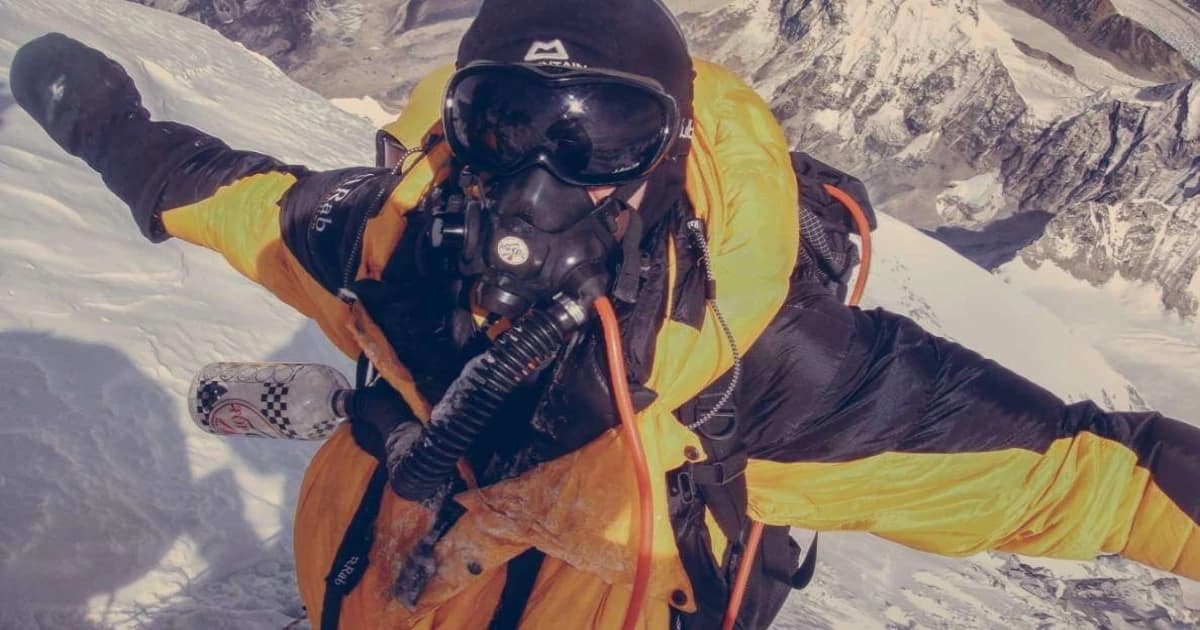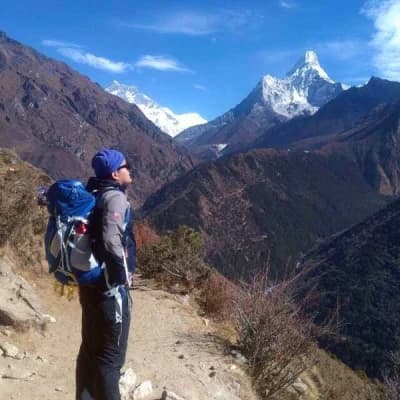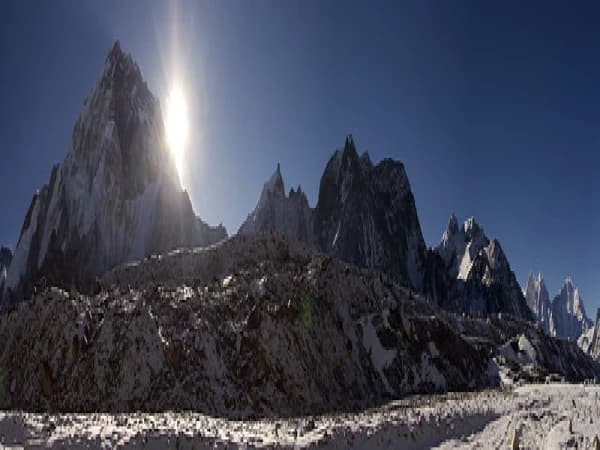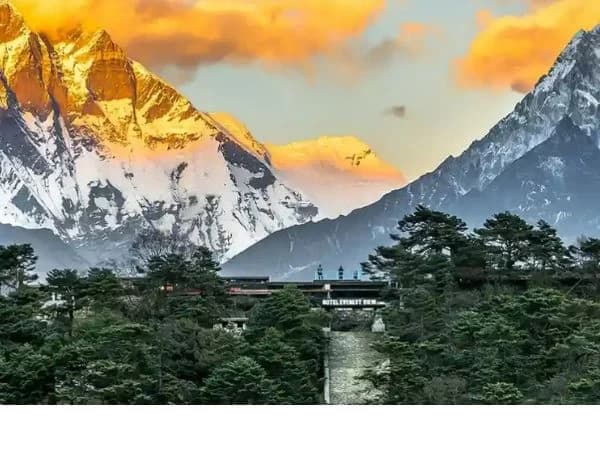Ever wonder how cold is M Everest? Well, let me tell you—it's not "grab a jacket" cold. It's brain-freezing, bone-freezing, breath-freezing cold. Climbing to the top of the world is like entering a deep freezer—only this one doesn't come with a door to exit the cold outside.
If you're doing an Everest Base Camp trek or marveling at the cold at the top of Everest, this is one thing you can count on: Everest isn't just cold, it's legendary.
Mount Everest Temperature at the Summit – The Freezing Throne of the World
At 8,848 meters (29,031 feet) above sea level, the summit temperature of Everest is as low as -60°C (-76°F) in winter. That is cold enough to freeze your breath even before you can exhale.
And don't think, "Well, summer is warmer." Even during the midsummer months, the Mount Everest summit temperature never rises much above -20°C (-4°F). Add hurricane-strength winds of more than 280 km/h (174 mph), and you have an environment so unpleasant that even experienced climbers must plan every step.
It is not a matter of brute strength here—it is a matter of enduring the most severe, most unforgiving habitat on Earth.
Why is Mount Everest So Cold?
So why is Mount Everest so cold? The answer lies in a deadly mix of altitude, thin air, and persistent winds.
Everest Altitude Cold:
The higher you climb, the thinner the air. At the Mt Everest summit, there's only one-third as much oxygen as at sea level. With less oxygen, your body is less able to produce heat, and it's harder to stay warm.
Windchill Madness:
Mount Everest Summit winds blow at 280 km/h (174 mph)—stronger than most hurricanes! When wind and cold join forces, the real-feel temperature plunges below the thermometer.
The Wrath of the Jet Stream:
Everest is squarely in the crosshairs of the Jet Stream, a violent high-altitude wind that brings tempestuous weather, sudden storms, and a relentless freeze.
In short, Everest's cold isn't just a numbers game—it's an all-out atmospheric cold!
Death Zone Temperature on Everest
On the summit of Mount Everest, the mountaineers are greeted with an incredibly hostile climate, but one that adds to the experience's splendor. At temperatures so frigid, even the most hardened traveler is readily tested, since frostbite grasps fingers, toes, or limbs in mere minutes.
The frozen flesh becomes instantaneously rigidly locked, but the survivors of such extreme cold can share stories of resilience and perseverance. While hypothermia is a risk, inducing confusion and exhaustion, climbers push on resolutely, fighting nature's forces step by step.
In the "Death Zone" above 8,000 meters (26,247 feet), limited oxygen and below-freezing temperatures may add to the difficulty of the ascent, but so does the human spirit. It's not about the summit as much—it's about overcoming the odds, remaining strong, and embarking on the ultimate journey.

Wind on Everest
Just in case the temperatures aren't bad enough, think about the winds. The winds on Everest are not merely powerful—these are ruthless winds.
280 km/h (174 mph) winds so vicious they can knock a climber off track or stiffen exposed skin in seconds.
The wind chill effect lowers the actual temperature yet again. -30°C (-22°F) could feel as cold as -50°C (-58°F) when blown directly at full power.
Whiteouts and storms come on in a flash, so a dangerous climb becomes a test of survival.
Cold, wind, and high altitude have claimed so many lives of mountaineers. It's not climbing to the top—it's making it down alive.
The Perfect Temperature to Summit Everest: When to Visit the Mountain
Everest is not really a mountain that one would want to just ascend anywhere and at any time. It's something that calls for well-planned thinking, and timing-wise, is no exception. The cold, unpredictable weather, and season-changing circumstances along the route of the year would either make or break your adventure. So, the ideal time to climb Everest?
Spring: The Prime of the Pinnacle
In your bid to reach the top, April to May is your window of opportunity.
Spring is the most stable weather, and temperatures, though still frigid, are far more bearable than in winter. Summit temperatures are around -20°C (-4°F)—chilly, yes, but tolerable with the appropriate gear. And the weather is more predictable, which means a safer, more successful ascent. Most climbers opt for this time for their Everest ascents, so if you want to be one of them, this is your best chance to conquer the giant mountain!
Autumn: A Quiet, Tough Option
Not a fan of the crowds? Try September to November. This is the second-best time to climb Everest.
The temperatures are still harsh, around -30°C (-22°F)—but the advantage is fewer climbers on the mountain. So, if you’re looking for a quieter, more personal experience, autumn might be the right season for you. Just remember, the cold still packs a punch, so proper gear is a must.
Avoid the Monsoon (Summer) Months
When it comes to summer (June to August), it’s best to skip the climb. T
his is monsoon season in Nepal, which brings unpredictable weather, heavy rain, and an increased risk of avalanches. While temperatures are warmer than in winter, wet and slippery conditions make climbing much more dangerous. If you’re serious about summiting, avoid these months and aim for spring or autumn instead.
Best Time to See the Summit of Mount Everest: When to Catch That Perfect View
If you’re more about experiencing the beauty of Everest without the climb, there are ideal times to visit and see the peak. Let’s talk about when you’ll get the best views of Everest’s summit.
Spring and Autumn
Spring and autumn are the best periods during which to spot Everest's top.
In these seasons, there are usually clear skies during the early mornings or late afternoon when the clearness is absolute. If trekking to the Base Camp or walking along lower altitudes, these months produce stunning views of the summit. It's best to appreciate the beauty of the mountain without any exposure to very cold temperatures in the higher places.
Winter
If you like to see Everest as a winter wonderland, then winter has some magical scenes to reveal.
Even when the weather is rough, with howling winds and bad visibility, there's something magical in viewing Everest shrouded in snow. It's a serene, barren time to ascend lower on the mountain, and if fortune smiles upon you, you may be able to capture stunning photos of the summit. Just get used to the cold—it's rather the view from a distance than the climb to the top!
Avoid the Monsoon Season for the Best View
Monsoon time (June to August) is not the best time to travel to Everest if you are seeking the best view. With rain, dense clouds, and bad weather, you will not enjoy those wonderful views you have been dreaming about. Additionally, the wet and slippery roads increase the risk of the climb considerably. Wait for spring or fall for the best views.
Why Everest's Cold Temperature is Worth Experiencing?
You might ask, Why would I ever want to be in that kind of cold? Here's why:
✅ It's an Adventure Like No Other – Everest's cold isn't so much about temperature as it's about adventure, challenge, and bragging rights for having been where only the bravest have been.
✅ The Views Are Unmatched – The colder it gets, the clearer the skies. Imagine seeing the Himalayan giants bathed in golden sunrise light, untouched snow glistening, and the world stretching below you.
✅ You’ll Feel Truly Alive – There’s something incredible about breathing in the crisp, high-altitude air, pushing through the cold, and realizing you’re walking in the footsteps of legends.
Mount Everest Temperature According to Seasons
Everest is always frigid. However, temperatures take a dramatic plunge, especially in winter.
During the summer season, trekkers can expect temperatures around -19°C (-3°F) and lows dipping to -32°C (-26°F). It's the preferred season for hikers, which offers a relatively comfortable trekking experience compared to winter.
Winter (December to February) is freezing. Temperatures can drop to a shocking -60°C (-76°F) or even lower. The strong winds make it feel even colder. Climbing is super dangerous during this time. Spring and autumn are in-between settings in the freezer. The weather can be unpredictable, with some days feeling more like winter and others a bit more like summer.
What is the Average Temperature on Mt. Everest?
Everest is extremely brutal and freezing, but how cold does it actually get on the "roof of the world"? Buckle up, the average temperature on Everest varies depending on altitude and season. However, a general estimate is around -30°C (-22°F).
How Cold is the Top of Mt Everest?
The top of Mount Everest is probably one of the oldest places on Earth. Now imagine stepping on such an iconic mountain whose average temperature is jaw-dropping -36°C (-33°F). That's enough to make your teeth chatter and your fingers go numb in seconds.
But wait, it gets even colder during the harsh winter months, temperatures on Everest can plummet to a shocking -60°C (-76°F). That's colder than the average freezer temperature, and surviving it for even a short period requires serious protection and preparation.
How Hard Is It To Climb Mount Everest in Extreme Cold?
Everest may be a dream destination, but it's a dream that comes with a price tag. The first challenge will be maintaining physical strength at such a height. Everest isn't just cold, and the temperature can stiffen muscles, making even basic movements like climbing and walking incredibly difficult. Exerting yourself in such a harsh environment is mentally draining, making it harder to focus and concentrate. This can lead to poor decision-making and an increased risk of mistakes, which can be deadly on Everest.
Enduring the cold and maintaining stability at the same time make technical climbing tasks much harder. Setting up camp, using essential climbing gear like ropes and ice axes, and performing even routine maintenance becomes difficult when your fingers are numb and your movements are stiff. This can significantly slow down climbers and add to the overall danger of the ascent.
The climb itself is no walk in the park. Climbers must navigate crevasses, use specialized equipment like ice axes and ropes, and make their way across challenging terrain – all while battling the elements and their own exhaustion.
Before starting your adventure, learn more about the challenges and difficulties of trekking to Everest Base Camp (EBC)!
In a nutshell, Everest's Cold is the stuff of Legends—So is the Experience!
Next time you're wrapped up at home with a cup of hot drink, and your mind wanders wondering how exactly Everest is so cold, do this: imagine this: you're standing atop the world with the scorching cold wind all around you, howling hurricane-force gales, and a merciless climate that has no sympathy to give.
If you're reading this, you're not dreaming of Everest—you're ready to embark on an adventure. Everest is not a destination—it's a feeling, an experience that will stay with you for the remainder of your life.
Everest is not just cold—it's a frozen wasteland where only the strongest survive. The cold here isn't part of the trip; it's what constitutes it
FAQs
What is the coldest Mt. Everest has ever been on Everest?
The recorded all-time low on Mount Everest is a bone-chilling -60°C (-76°F). This frigid temperature highlights the mountain's extreme environment.
Can you stay warm on Mount Everest?
Staying warm on Everest is a constant battle. Specialized clothing, proper layering, and staying active all play a crucial role. However, even with the best gear, the extreme cold and wind chill can make it difficult to stay truly comfortable.
Is there less oxygen on Mt Everest?
Yes, there is significantly less oxygen on Mount Everest due to its high altitude. The air pressure drops as you climb, meaning there are fewer oxygen molecules available for your body to use. This is why climbers experience difficulty breathing and often require supplemental oxygen.
Is it always cold on Mt. Everest?
Everest is always frigid, but there are slight variations depending on the season. Summers offer a slight relief, with highs occasionally reaching -19°C (-3°F). However, winters are brutally harsh, with temperatures regularly dipping below -60°C (-76°F).
What should I do if I encounter cold-related health issues while climbing Mount Everest?
If you experience cold-related health issues like hypothermia while climbing Everest, immediate descent is critical. Climbers should be trained to recognize the symptoms and take swift action to seek shelter and warmth. Medical attention is often necessary in such situations.




.webp&w=1200&q=75&dpl=dpl_2PwU5ZDv8uoJ3KrzEVbz8N547HgX)
.webp&w=1200&q=75&dpl=dpl_2PwU5ZDv8uoJ3KrzEVbz8N547HgX)
.webp&w=1200&q=75&dpl=dpl_2PwU5ZDv8uoJ3KrzEVbz8N547HgX)
.webp&w=1200&q=75&dpl=dpl_2PwU5ZDv8uoJ3KrzEVbz8N547HgX)